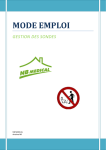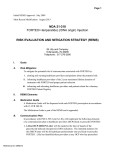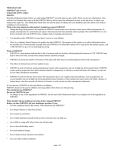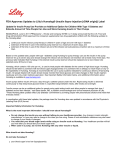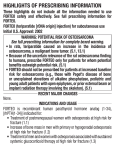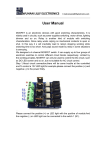Download /C O R R E C T I O N -- Eli Lilly and Company/
Transcript
/C O R R E C T I O N -- Eli Lilly and Company/ --In the news release, FDA Approves Expanded Use of Lilly's (NYSE: LLY) FORTEO(R) [teriparatide (rDNA origin) injection] to Treat Glucocorticoid- Induced Osteoporosis, issued earlier today by Eli Lilly and Company over PR Newswire, we are advised by the company that the first sentence of the seventh paragraph under the heading "Important Safety Information about FORTEO," should read "FORTEO can cause serious side effects including a decrease in blood pressure" rather than "increase in blood pressure" as originally issued inadvertently. Complete, corrected release follows: FDA Approves Expanded Use of Lilly's FORTEO(R) [teriparatide (rDNA origin) injection] to Treat Glucocorticoid-Induced Osteoporosis First and only FDA-approved anabolic agent in the U.S. now indicated to treat the leading type of secondary osteoporosis INDIANAPOLIS, July 23, 2009 /PRNewswire-FirstCall via COMTEX News Network/ -- Today, Eli Lilly and Company (NYSE: LLY) announced that the U.S. Food and Drug Administration (FDA) has approved a new use for its osteoporosis drug FORTEO(R) [teriparatide (rDNA origin) injection] to treat osteoporosis associated with sustained, systemic glucocorticoid therapy in men and women at high risk of fracture. Glucocorticoid therapy is the most common cause of secondary osteoporosis, leading to bone loss and an increased risk for fracture.(1) "Patients who take long-term glucocorticoid therapy are already dealing with a serious health condition, and, on top of that, they may be at a significantly higher risk for fracture," said Vladimir Kopernicky, medical director for Eli Lilly and Company. "The FDA's decision provides these patients with a valuable treatment option for osteoporosis, which they may develop as a result of their sustained glucocorticoid use." Glucocorticoid-induced osteoporosis, or GIO, is associated with chronic use of glucocorticoid medications, which are often prescribed for inflammatory conditions such as rheumatoid arthritis and obstructive pulmonary disease. Data indicate that glucocorticoid medications are used by up to three out of every 100 adults over age 50. (2) Approximately 50 percent of individuals who are prescribed chronic glucocorticoid therapy will eventually have an osteoporotic fracture.(3) The use of glucocorticoid medications can lead to a reduction in bone formation.(4) FORTEO has been shown to counter this effect by stimulating bone formation.(5) In the course of the FDA's review of the new indication, Lilly provided data from a clinical study which showed that in patients with glucocorticoid- induced osteoporosis, FORTEO increased bone mineral density (BMD) from baseline to 18 months of treatment by 7.2 percent at the lumbar spine, 3.6 percent at the total hip, and 3.7 percent at the femoral neck.(5) "Until now, physicians and patients had only one class of approved therapy for the treatment of glucocorticoid-induced osteoporosis," said Kenneth G. Saag, M.D., MSc, professor of medicine and epidemiology at the University of Alabama in Birmingham. "The approval of teriparatide for this new indication offers healthcare providers and patients a new treatment option that effectively increases bone mineral density in a different way than anti- resorptives." Label Updates Since this new indication extends the use of FORTEO to patients with GIO who may be younger than those currently receiving the medication, Lilly has updated the language in the existing boxed warning section of the label regarding the risk of osteosarcoma to reinforce that FORTEO should not be used in pediatric and young adult patients whose bones are still growing. In addition, due to the increased patient population, Lilly established a voluntary FORTEO Patient Registry to further evaluate the long-term safety of FORTEO. Osteosarcoma is a serious but rare cancer which occurs at a rate of about four cases per million people, per year. Osteosarcoma has been reported rarely in people who took FORTEO. It is not known if people who take FORTEO have a higher chance of getting osteosarcoma. About FORTEO FORTEO is also indicated for the treatment of osteoporosis in postmenopausal women who are at high risk for fracture and to increase bone mass in men with primary or hypogonadal osteoporosis who are at high risk for fracture.(6) FORTEO is the first osteoporosis therapy approved by the U.S. Food and Drug Administration (FDA) that actually rebuilds bone.(7) Since receiving FDA approval in November 2002, more than 3.1 million prescriptions for FORTEO have been filled in the United States.(8) Important Safety Information about FORTEO During the drug testing process, the medicine in FORTEO caused some rats to develop a bone cancer called osteosarcoma. In people, osteosarcoma is a serious but rare cancer. Osteosarcoma has been reported rarely in people who took FORTEO. It is not known if people who take FORTEO have a higher chance of getting osteosarcoma. You should not take FORTEO for more than 2 years over your lifetime. There is a voluntary Patient Registry for people who take FORTEO. The purpose of the registry is to collect information about the possible risk of osteosarcoma in people who take FORTEO. For information about how to sign up for this patient registry, call 1-866-382-6813 or go to www.forteoregistry.rti.org. Do not use FORTEO if you are allergic to any of the ingredients in FORTEO. Before you take FORTEO, you should tell your healthcare provider if you have Paget's disease or other bone disease; have cancer in your bones; have trouble injecting yourself and do not have someone who can help you; are a child or young adult whose bones are still growing or have or have had kidney stones; if you have had radiation therapy; have or had too much calcium in your blood; have any other medical conditions; or take medications that contain digoxin (Digoxin, Lanoxicaps, Lanoxin). Please consult your healthcare provider if you are pregnant or thinking about becoming pregnant. It is not known if FORTEO will harm your unborn baby. If you are breast-feeding or plan to breast-feed, it is not known if FORTEO passes into your breast milk. You and your doctor should decide if you will take FORTEO or breast feed. You should not do both. FORTEO can cause serious side effects including a decrease in blood pressure when you change positions. Some people feel dizzy, get a fast heartbeat, or feel faint right after the first few doses. This usually happens within 4 hours of taking FORTEO and goes away within a few hours. For the first few doses, take your injections of FORTEO in a place where you can sit or lie down right away if you get these symptoms. If your symptoms get worse or do not go away, stop taking FORTEO and call your healthcare provider. Serious side effects also include increased calcium in your blood. Tell your healthcare provider if you have nausea, vomiting, constipation, low energy, or muscle weakness. These may be signs there is too much calcium in your blood. Common side effects of FORTEO include nausea, joint aches, pain, leg cramps, and injection site reactions such as redness, swelling, pain, itching, a few drops of blood, and bruising. These are not all the possible side effects of FORTEO. The FORTEO delivery device has enough medicine for 28 days. It is set to give a 20 microgram dose of medicine each day. Do not inject all the medicine in the FORTEO delivery device at any one time. Inject FORTEO one time each day in your thigh or abdomen (lower stomach area). Talk to a healthcare provider about how to rotate injection sites. Do not transfer the medicine from the FORTEO delivery device to a syringe. This can result in taking the wrong dose of FORTEO. If you do not have pen needles to use with your FORTEO delivery device, talk with your healthcare provider. If you take more FORTEO than prescribed, call your healthcare provider. If you take too much FORTEO, you may have nausea, vomiting, weakness or dizziness. Keep your FORTEO delivery device in the refrigerator between 36 degrees to 46 degrees F (2 degrees to 8 degrees C). Do not freeze the FORTEO delivery device. Do not use FORTEO if it has been frozen. Do not use FORTEO after the expiration date printed on the delivery device and packaging. Throw away the FORTEO delivery device after 28 days even if it has medicine in it (see the User Manual). For more information about FORTEO, including full prescribing information, visit www.Forteo.com. About Lilly Lilly, a leading innovation-driven corporation, is developing a growing portfolio of pharmaceutical products by applying the latest research from its own worldwide laboratories and from collaborations with eminent scientific organizations. Headquartered in Indianapolis, Ind., Lilly provides answers -- through medicines and information -- for some of the world's most urgent medical needs. Additional information about Lilly is available at www.lilly.com. P-LLY Forward Looking Statement This press release contains forward-looking statements about the safety and efficacy of FORTEO and reflects Lilly's current beliefs. However, as with any pharmaceutical product, there are substantial risks and uncertainties in the process of development and commercialization. There is no guarantee that FORTEO will continue to be commercially successful. For further discussion of these and other risks and uncertainties, see Lilly's filings with the United States Securities and Exchange Commission. Lilly undertakes no duty to update forward-looking statements. (1) Trends Endocrinol. 2006; 17: 144-149. (2) Clin Rheumatol. 2007; 26: 144-153. (3) Endocrinol Metab Clin North Am. 2003; 32: 135-157. (4) Van Staa, TP "The Pathogenesis, Epidemiology and Management of Glucocorticoid-Induced Osteoporosis," Calcif Tissue Int. 2006; 79:129-137. (5) (6) (7) (8) N Engl J Med. 2007; 357:2028-39. FORTEO Prescribing Information. Curr Opin Orthop. 2003; 14:438-439. Data on file, Lilly Research Laboratories (FOR20081217A). (Logo: http://www.newscom.com/cgi-bin/prnh/20031219/LLYLOGO ) -----FDA Approves Expanded Use of Lilly's FORTEO(R) [teriparatide (rDNA origin) injection] to Treat Glucocorticoid-Induced Osteoporosis First and only FDA-approved anabolic agent in the U.S. now indicated to treat the leading type of secondary osteoporosis INDIANAPOLIS, July 23 /PRNewswire-FirstCall/ -- Today, Eli Lilly and Company (NYSE: LLY) announced that the U.S. Food and Drug Administration (FDA) has approved a new use for its osteoporosis drug FORTEO((R)) [teriparatide (rDNA origin) injection] to treat osteoporosis associated with sustained, systemic glucocorticoid therapy in men and women at high risk of fracture. Glucocorticoid therapy is the most common cause of secondary osteoporosis, leading to bone loss and an increased risk for fracture.(1) "Patients who take long-term glucocorticoid therapy are already dealing with a serious health condition, and, on top of that, they may be at a significantly higher risk for fracture," said Vladimir Kopernicky, medical director for Eli Lilly and Company. "The FDA's decision provides these patients with a valuable treatment option for osteoporosis, which they may develop as a result of their sustained glucocorticoid use." Glucocorticoid-induced osteoporosis, or GIO, is associated with chronic use of glucocorticoid medications, which are often prescribed for inflammatory conditions such as rheumatoid arthritis and obstructive pulmonary disease. Data indicate that glucocorticoid medications are used by up to three out of every 100 adults over age 50. (2) Approximately 50 percent of individuals who are prescribed chronic glucocorticoid therapy will eventually have an osteoporotic fracture.(3) The use of glucocorticoid medications can lead to a reduction in bone formation.(4) FORTEO has been shown to counter this effect by stimulating bone formation.(5) In the course of the FDA's review of the new indication, Lilly provided data from a clinical study which showed that in patients with glucocorticoid-induced osteoporosis, FORTEO increased bone mineral density (BMD) from baseline to 18 months of treatment by 7.2 percent at the lumbar spine, 3.6 percent at the total hip, and 3.7 percent at the femoral neck.(5) "Until now, physicians and patients had only one class of approved therapy for the treatment of glucocorticoid-induced osteoporosis," said Kenneth G. Saag, M.D., MSc, professor of medicine and epidemiology at the University of Alabama in Birmingham. "The approval of teriparatide for this new indication offers healthcare providers and patients a new treatment option that effectively increases bone mineral density in a different way than anti-resorptives." Label Updates Since this new indication extends the use of FORTEO to patients with GIO who may be younger than those currently receiving the medication, Lilly has updated the language in the existing boxed warning section of the label regarding the risk of osteosarcoma to reinforce that FORTEO should not be used in pediatric and young adult patients whose bones are still growing. In addition, due to the increased patient population, Lilly established a voluntary FORTEO Patient Registry to further evaluate the long-term safety of FORTEO. Osteosarcoma is a serious but rare cancer which occurs at a rate of about four cases per million people, per year. Osteosarcoma has been reported rarely in people who took FORTEO. It is not known if people who take FORTEO have a higher chance of getting osteosarcoma. About FORTEO FORTEO is also indicated for the treatment of osteoporosis in postmenopausal women who are at high risk for fracture and to increase bone mass in men with primary or hypogonadal osteoporosis who are at high risk for fracture.(6) FORTEO is the first osteoporosis therapy approved by the U.S. Food and Drug Administration (FDA) that actually rebuilds bone.(7) Since receiving FDA approval in November 2002, more than 3.1 million prescriptions for FORTEO have been filled in the United States.(8) Important Safety Information about FORTEO During the drug testing process, the medicine in FORTEO caused some rats to develop a bone cancer called osteosarcoma. In people, osteosarcoma is a serious but rare cancer. Osteosarcoma has been reported rarely in people who took FORTEO. It is not known if people who take FORTEO have a higher chance of getting osteosarcoma. You should not take FORTEO for more than 2 years over your lifetime. There is a voluntary Patient Registry for people who take FORTEO. The purpose of the registry is to collect information about the possible risk of osteosarcoma in people who take FORTEO. For information about how to sign up for this patient registry, call 1-866-382-6813 or go to www.forteoregistry.rti.org. Do not use FORTEO if you are allergic to any of the ingredients in FORTEO. Before you take FORTEO, you should tell your healthcare provider if you have Paget's disease or other bone disease; have cancer in your bones; have trouble injecting yourself and do not have someone who can help you; are a child or young adult whose bones are still growing or have or have had kidney stones; if you have had radiation therapy; have or had too much calcium in your blood; have any other medical conditions; or take medications that contain digoxin (Digoxin, Lanoxicaps, Lanoxin). Please consult your healthcare provider if you are pregnant or thinking about becoming pregnant. It is not known if FORTEO will harm your unborn baby. If you are breast-feeding or plan to breast-feed, it is not known if FORTEO passes into your breast milk. You and your doctor should decide if you will take FORTEO or breast feed. You should not do both. FORTEO can cause serious side effects including an increase in blood pressure when you change positions. Some people feel dizzy, get a fast heartbeat, or feel faint right after the first few doses. This usually happens within 4 hours of taking FORTEO and goes away within a few hours. For the first few doses, take your injections of FORTEO in a place where you can sit or lie down right away if you get these symptoms. If your symptoms get worse or do not go away, stop taking FORTEO and call your healthcare provider. Serious side effects also include increased calcium in your blood. Tell your healthcare provider if you have nausea, vomiting, constipation, low energy, or muscle weakness. These may be signs there is too much calcium in your blood. Common side effects of FORTEO include nausea, joint aches, pain, leg cramps, and injection site reactions such as redness, swelling, pain, itching, a few drops of blood, and bruising. These are not all the possible side effects of FORTEO. The FORTEO delivery device has enough medicine for 28 days. It is set to give a 20 microgram dose of medicine each day. Do not inject all the medicine in the FORTEO delivery device at any one time. Inject FORTEO one time each day in your thigh or abdomen (lower stomach area). Talk to a healthcare provider about how to rotate injection sites. Do not transfer the medicine from the FORTEO delivery device to a syringe. This can result in taking the wrong dose of FORTEO. If you do not have pen needles to use with your FORTEO delivery device, talk with your healthcare provider. If you take more FORTEO than prescribed, call your healthcare provider. If you take too much FORTEO, you may have nausea, vomiting, weakness or dizziness. Keep your FORTEO delivery device in the refrigerator between 36 degrees to 46 degrees F (2 degrees to 8 degrees C). Do not freeze the FORTEO delivery device. Do not use FORTEO if it has been frozen. Do not use FORTEO after the expiration date printed on the delivery device and packaging. Throw away the FORTEO delivery device after 28 days even if it has medicine in it (see the User Manual). For more information about FORTEO, including full prescribing information, visit www.Forteo.com. About Lilly Lilly, a leading innovation-driven corporation, is developing a growing portfolio of pharmaceutical products by applying the latest research from its own worldwide laboratories and from collaborations with eminent scientific organizations. Headquartered in Indianapolis, Ind., Lilly provides answers -- through medicines and information -- for some of the world's most urgent medical needs. Additional information about Lilly is available at www.lilly.com. P-LLY Forward Looking Statement This press release contains forward-looking statements about the safety and efficacy of FORTEO and reflects Lilly's current beliefs. However, as with any pharmaceutical product, there are substantial risks and uncertainties in the process of development and commercialization. There is no guarantee that FORTEO will continue to be commercially successful. For further discussion of these and other risks and uncertainties, see Lilly's filings with the United States Securities and Exchange Commission. Lilly undertakes no duty to update forward-looking statements. (1) Trends Endocrinol. 2006; 17: 144-149. (2) Clin Rheumatol. 2007; 26: 144-153. (3) Endocrinol Metab Clin North Am. 2003; 32: 135-157. (4) Van Staa, TP "The Pathogenesis, Epidemiology and Management of Glucocorticoid-Induced Osteoporosis," Calcif Tissue Int. 2006; 79:129-137. (5) N Engl J Med. 2007; 357:2028-39. (6) FORTEO Prescribing Information. (7) Curr Opin Orthop. 2003; 14:438-439. (8) Data on file, Lilly Research Laboratories (FOR20081217A). (Logo: http://www.newscom.com/cgi-bin/prnh/20031219/LLYLOGO ) SOURCE Eli Lilly and Company Copyright (C) 2009 PR Newswire. All rights reserved





